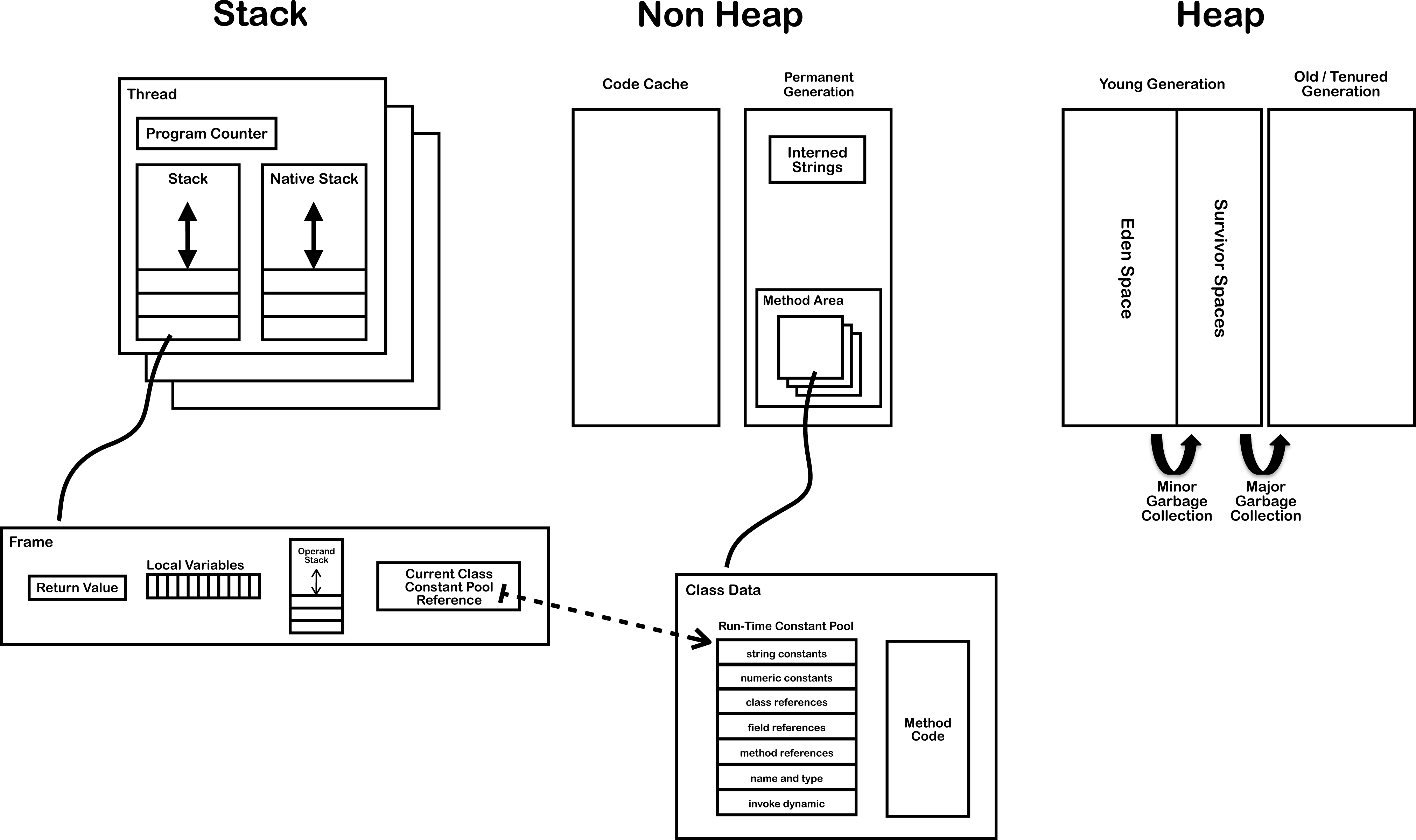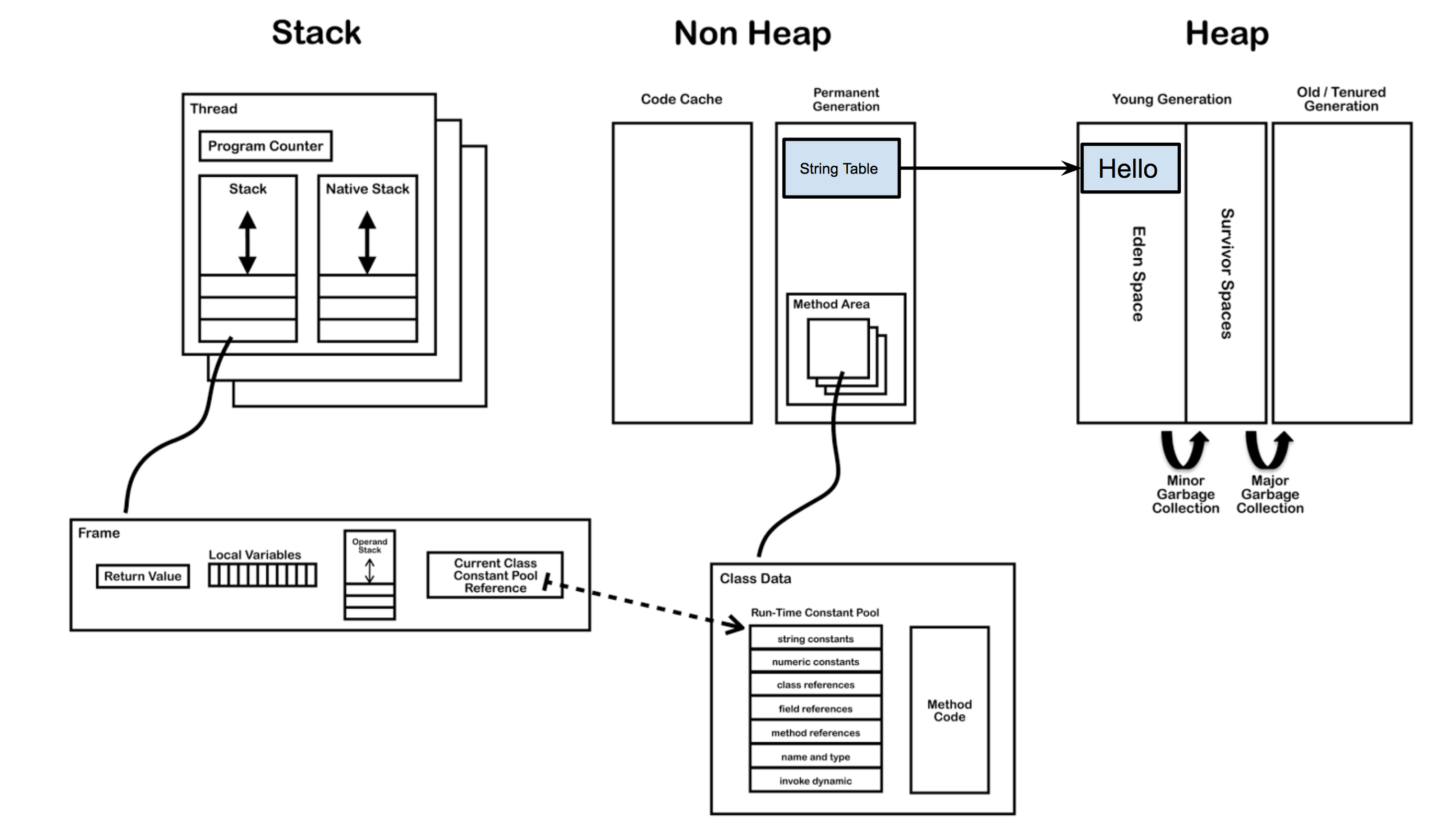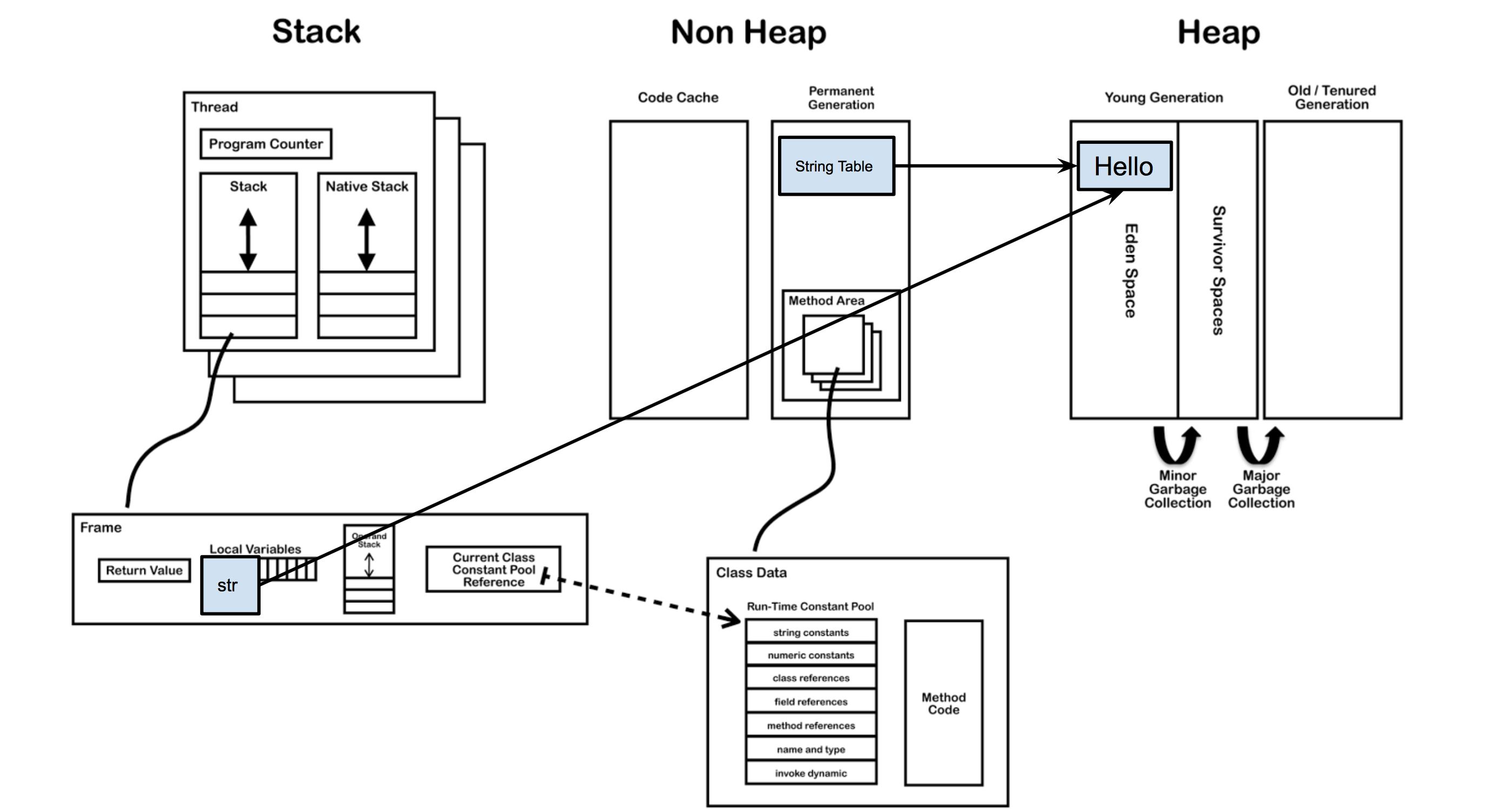String s1 = "Hello"; String s2 = "Hello"; String s3 = "Hel" + "lo"; String s4 = "Hel" + new String("lo"); String s5 = new String("Hello"); String s6 = s5.intern(); String s7 = "H"; String s8 = "ello"; String s9 = s7 + s8; System.out.println(s1 == s2); // true System.out.println(s1 == s3); // true System.out.println(s1 == s4); // false System.out.println(s1 == s9); // false System.out.println(s4 == s5); // false System.out.println(s1 == s6); // true
刚开始看字符串的时候,经常会看到类似的题,难免会有些不解,查看答案总会提到字符串常量池、运行常量池等概念,很容易让人搞混。
下面就来说说Java中的字符串到底是怎样创建的。
Java内存区域
String有两种赋值方式,第一种是通过“字面量”赋值。
String str = "Hello";
String str = new String("Hello");
要弄清楚这两种方式的区别,首先要知道他们在内存中的存储位置。

图片来源:http://286.iteye.com/blog/1928180
我们平时所说的内存就是图中的运行时数据区(Runtime Data Area),其中与字符串的创建有关的是方法区(Method Area)、堆区(Heap Area)和栈区(Stack Area)。
- 方法区:存储类信息、常量、静态变量。全局共享。
- 堆区:存放对象和数组。全局共享。
- 栈区:基本数据类型、对象的引用都存放在这。线程私有。
每当一个方法被执行时就会在栈区中创建一个栈帧(Stack Frame),基本数据类型和对象引用就存在栈帧中局部变量表(Local Variables)。
当一个类被加载之后,类信息就存储在非堆的方法区中。在方法区中,有一块叫做运行时常量池(Runtime Constant Pool),它是每个类私有的,每个class文件中的“常量池”被加载器加载之后就映射存放在这,后面会说到这一点。
和String最相关的是字符串池(String Pool),其位置在方法区上面的驻留字符串(Interned Strings)的位置,之前一直把它和运行时常量池搞混,其实是两个完全不同的存储区域,字符串常量池是全局共享的。字符串调用String.intern()方法后,其引用就存放在String Pool中。
两种创建方式在内存中的区别
了解了这些概念,下面来说说究竟两种字符串创建方式有何区别。
下面的Test类,在main方法里以“字面量”赋值的方式给字符串str赋值为“Hello”。
public class Test { public static void main(String[] args) { String str = "Hello"; } }
Test.java文件编译后得到.class文件,里面包含了类的信息,其中有一块叫做常量池(Constant Pool)的区域,.class常量池和内存中的常量池并不是一个东西。
.class文件常量池主要存储的就包括字面量,字面量包括类中定义的常量,由于String是不可变的(String为什么是不可变的?),所以字符串“Hello”就存放在这。
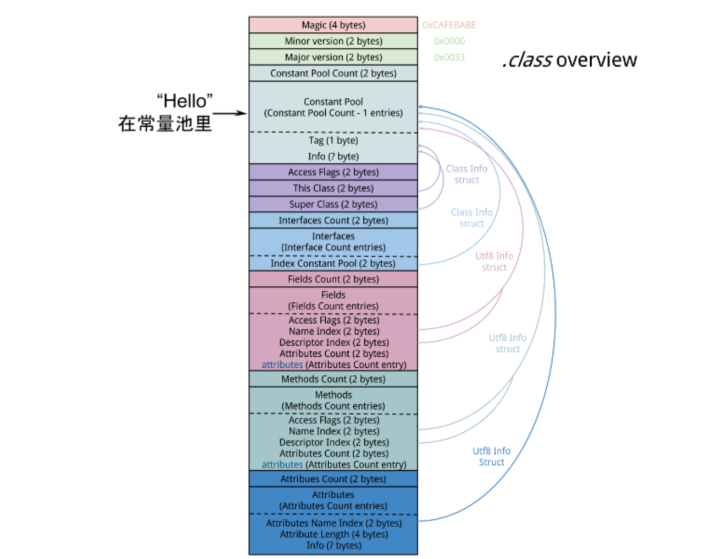
当程序用到Test类时,Test.class被解析到内存中的方法区。.class文件中的常量池信息会被加载到运行时常量池,但String不是。
例子中“Hello”会在堆区中创建一个对象,同时会在字符串池(String Pool)存放一个它的引用,如下图所示。
此时只是Test类刚刚被加载,主函数中的str并没有被创建,而“Hello”对象已经创建在于堆中。
当主线程开始创建str变量的,虚拟机会去字符串池中找是否有equals(“Hello”)的String,如果相等就把在字符串池中“Hello”的引用复制给str。如果找不到相等的字符串,就会在堆中新建一个对象,同时把引用驻留在字符串池,再把引用赋给str。
当用字面量赋值的方法创建字符串时,无论创建多少次,只要字符串的值相同,它们所指向的都是堆中的同一个对象。
public class Test { public static void main(String[] args) { String str1 = "Hello"; String str2 = “Hello”; String str3 = “Hello”; } }
当利用new关键字去创建字符串时,前面加载的过程是一样的,只是在运行时无论字符串池中有没有与当前值相等的对象引用,都会在堆中新开辟一块内存,创建一个对象。
public class Test { public static void main(String[] args) { String str1 = "Hello"; String str2 = “Hello”; String str3 = new String("Hello"); } }
解释开头的例子
现在我们来回头看之前的例子。
String s1 = "Hello"; String s2 = "Hello"; String s3 = "Hel" + "lo"; String s4 = "Hel" + new String("lo"); String s5 = new String("Hello"); String s6 = s5.intern(); String s7 = "H"; String s8 = "ello"; String s9 = s7 + s8; System.out.println(s1 == s2); // true System.out.println(s1 == s3); // true System.out.println(s1 == s4); // false System.out.println(s1 == s9); // false System.out.println(s4 == s5); // false System.out.println(s1 == s6); // true
有了上面的基础,之前的问题就迎刃而解了。
s1在创建对象的同时,在字符串池中也创建了其对象的引用。
由于s2也是利用字面量创建,所以会先去字符串池中寻找是否有相等的字符串,显然s1已经帮他创建好了,它可以直接使用其引用。那么s1和s2所指向的都是同一个地址,所以s1==s2。
s3是一个字符串拼接操作,参与拼接的部分都是字面量,编译器会进行优化,在编译时s3就变成“Hello”了,所以s1==s3。
s4虽然也是拼接,但“lo”是通过new关键字创建的,在编译期无法知道它的地址,所以不能像s3一样优化。所以必须要等到运行时才能确定,必然新对象的地址和前面的不同。
同理,s9由两个变量拼接,编译期也不知道他们的具体位置,不会做出优化。
s5是new出来的,在堆中的地址肯定和s4不同。
s6利用intern()方法得到了s5在字符串池的引用,并不是s5本身的地址。由于它们在字符串池的引用都指向同一个“Hello”对象,自然s1==s6。
总结一下:
- 字面量创建字符串会先在字符串池中找,看是否有相等的对象,没有的话就在堆中创建,把地址驻留在字符串池;有的话则直接用池中的引用,避免重复创建对象。
- new关键字创建时,前面的操作和字面量创建一样,只不过最后在运行时会创建一个新对象,变量所引用的都是这个新对象的地址。
由于不同版本的JDK内存会有些变化,JDK1.6字符串常量池在永久代,1.7移到了堆中,1.8用元空间代替了永久代。但是基本对上面的结论没有影响,思想是一样的。
intern()方法
下面来说说跟字符常量池有关的intern()方法。
/** * Returns a canonical representation for the string object. * <p> * A pool of strings, initially empty, is maintained privately by the * class {@code String}. * <p> * When the intern method is invoked, if the pool already contains a * string equal to this {@code String} object as determined by * the {@link #equals(Object)} method, then the string from the pool is * returned. Otherwise, this {@code String} object is added to the * pool and a reference to this {@code String} object is returned. * <p> * It follows that for any two strings {@code s} and {@code t}, * {@code s.intern() == t.intern()} is {@code true} * if and only if {@code s.equals(t)} is {@code true}. * <p> * All literal strings and string-valued constant expressions are * interned. String literals are defined in section 3.10.5 of the * <cite>The Java™ Language Specification</cite>. * * @return a string that has the same contents as this string, but is * guaranteed to be from a pool of unique strings. */ public native String intern();
这个方法是一个本地方法,注释中描述得很清楚:“如果常量池中存在当前字符串,就会直接返回当前字符串;如果常量池中没有此字符串,会将此字符串放入常量池中后,再返回”。
由于上面提到JDK1.6之后,字符串常量池在内存中的位置发生了变化,所以intern()方法在不同版本的JDK中也有所差别。
来看下面的代码:
public static void main(String[] args) { String s = new String("1"); s.intern(); String s2 = "1"; System.out.println(s == s2); String s3 = new String("1") + new String("1"); s3.intern(); String s4 = "11"; System.out.println(s3 == s4); }
在JDK1.6中的运行结果是false false,而在1.7中结果是false true。
将intern()语句下移一行。
public static void main(String[] args) { String s = new String("1"); String s2 = "1"; s.intern(); System.out.println(s == s2); String s3 = new String("1") + new String("1"); String s4 = "11"; s3.intern(); System.out.println(s3 == s4); }
在JDK1.6中的运行结果是false false,在1.7中结果也是false false。
下面来解释一下JDK1.6环境下的结果:

图中绿色线条代表string对象的内容指向,黑色线条代表地址指向。
JDK1.6中的intern()方法只是返回常量池中的引用,上面说过,常量池中的引用所指向的对象和new出来的对象并不是一个,所以他们的地址自然不相同。
接着来说一下JDK1.7:
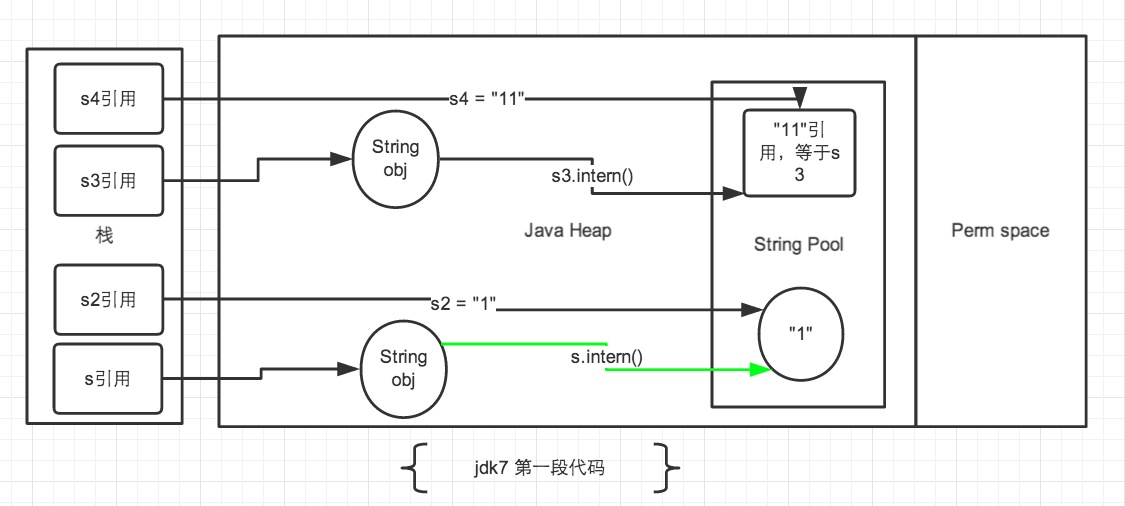
再贴一下代码
public static void main(String[] args) { String s = new String("1"); s.intern(); String s2 = "1"; System.out.println(s == s2); String s3 = new String("1") + new String("1"); s3.intern(); String s4 = "11"; System.out.println(s3 == s4); }
创建s3生成了两个最终对象(不考虑两个new String("1"),常量池中也没有“11”),一个是s3,另一个是池中的“1”。如果在1.6中,s3调用intern()方法,则先在常量池中寻找是否有等于“11”的对象,本例中自然是没有,然后会在堆中创建一个“11”的对象,并在常量池中存储它的引用并返回。然而在1.7中调用intern(),如果这个字符串在常量池中是第一次出现,则不会重新创建对象,直接返回它在堆中的引用。在本例中,s4和s3指向的都是在堆中的那个对象,所以s3和s4的地址相等。
由于s是new出来的,所以会在常量池和堆中创建两个不同的对象,s.intern()后,发现“1”并不是第一次出现在常量池了,所以接下来就和之前没有区别了。

public static void main(String[] args) { String s = new String("1"); String s2 = "1"; s.intern(); System.out.println(s == s2); String s3 = new String("1") + new String("1"); String s4 = "11"; s3.intern(); System.out.println(s3 == s4); }
将intern()语句下移一行后,执行顺序发生改变,执行到intern()时,字符串常量池已经存在“1”和“11”了,并不是第一次出现,字面量对象依然指向的是常量池,所以字面量创建的对象和new的对象地址一定是不同的。
转载请注明原文链接:http://www.cnblogs.com/justcooooode/p/7603381.html
参考资料
https://www.zhihu.com/question/29884421/answer/113785601
http://www.cnblogs.com/iyangyuan/p/4631696.html
https://tech.meituan.com/in_depth_understanding_string_intern.html
https://javaranch.com/journal/200409/ScjpTipLine-StringsLiterally.html ——【译】Java中的字符串字面量
